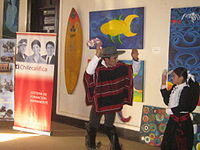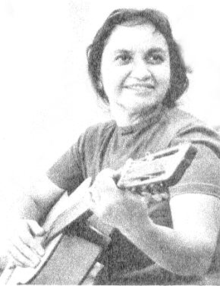- Music of Chile
-
Music of Chile: Topics Nueva Canción Cueca Payada Cumbia Sound Chilean rock Andean music Hip-Hop New Chilean Cumbia Mapuche music History Festivals Viña del Mar National anthem "Himno Nacional" South American music Argentina - Bolivia - Brazil - Colombia - Ecuador - Paraguay - Peru - Uruguay - Venezuela The music of Chile ranges from folkloric music, popular music and also to classical music.
Contents
Folk music
Chile has a very rich folklore music that has three different continental geographical zones: northern, central, and southern, each with their own characteristics and sounds. Also it has other musical expressions like Easter Island music and Mapuche music.[1] Central folk music is the most well-known.
Northern Chile was the center of culture in ancient Tahuantinsuyu (Inca empire), and was afterwards dominated by the Spanish. In the north of the country, traditional dances are strongly influenced by Quechua and Aymara culture, which covers parts of Peru, the Andean region of Bolivia and northern Chile. The dances are basic piece of popular piety and in activities linked to the ancient Inca religion and now have a semblance of paganism, as in the case of livestock enfleurage. Outside the cueca northerners, dance highlights include the trot and cachimbo.
Cueca
The cueca (short for zamacueca) has long been considered the "most popular air of Chile";[2] it first appeared in 1824. The cueca is always in a major key and is written in six-eight time with accompaniment in three-four. According to Pedro Humberto Allende, a Chilean composer, "neither the words nor the music obey any fixed rules; various motives are freely intermingled. The number of bars is from twenty-six to thirty, and there is usually an instrumental introduction twelve to one hundred bars in length. The last note of the melody is either the third or the fifth of the scale, never the octave".[3]
The Tonada is another important form of Chilean traditional song, arising from the music brought by Spanish settlers. It is distinguished from the cueca by an intermediate melodic section and a more prominent melody in general; the tonada is also not danced. There have been several groups who took the Tonada as their main form of expression, such as Los Huasos Quincheros, Los Huasos de Algarrobal, Los de Ramon and others. Other less known styles are: the Sirilla, the Sajuriana, Refalosa, Polka.
Between 1950 and 1970 appeared a rebirth in folk music led by groups such as Los de Ramon, Los Cuatro Huasos, and Los Huasos Quincheros among others.[4][5] There also appeared Chilean folk music composers such as Raul de Ramon, Violeta Parra, Luis Aguirre Pinto, among others who raised up folkloric music and have done research in this area and also in Latin American music. Margot Loyola is another well-known Chilean musician and folk singer who has also been a renowned and active researcher of the folklore of her country and, in general, of Latin America. Vicente Bianchi Alarcón is an accomplished Chilean composer, pianist, and director of Los Coros y Orquesta Chileno. In 2004, he was awarded the Premio a lo Chileno. He is also famous for his work with Pablo Neruda.
Chile also has important classic composers such as Alfonso Leng, Pedro Humberto Allende, Domingo Santa Cruz and others.[6] Also great pianists have come from this country such as Claudio Arrau who is considered one of the greatest pianists of the 20th century,[citation needed] also Rosita Renard and Alfredo Pearl. One of the most important clavecinist of our days Lionel Party was also born in Chile.[7] From this country are also singers such as Ramon Vinay, Cristina Gallardo-Domas, Victoria Vergara and Veronica Villarroel
Traditional Folklore
Between 1930 and 1960 appears a rebirth of traditional folklore initially promoved by the Group Los Cuatro Huasos that took folk country music and started popularizing and spreading it not only in Chile also in others countries in Latino America and USA.[8]
After them appeared a lot of important folkloric groups such as Los de Ramon, Los Huasos Quincheros, El Duo Rey Silva, Los Cantores de Santa Cruz and others that made very popular folk music in Chile and also in Latin America. Also appeared several important folk composers who investigated, took the roots of folk music and made it well-known such as Raul de Ramon, Violeta Parra, Margot Loyola, Luis Aguirre Pinto, Clara Solovera among others.[9][10] They did not have political motivations, but rather interest in recovering and spreading the traditional folkloric music of Chile.
However, a new Chilean song would appear afterwards which did have political implications.
"La Nueva Canción Chilena" (The New Chilean Song)
In the mid-1960s appeared singers and composers such as Ángel, Isabel and Violeta Parra that began playing in Santiago, popularizing Aymara and Quechua music. The Parras were connected to Gilbert Favre, Swiss-Frenchman who later became a member of the influential Bolivian group Los Jairas.
Arising out of the revitalization in Andean music in the 1960s, nueva canción soon emerged in Argentina and, especially, Chile. Born during a period of political struggle across Latin America, nueva canción became associated with political activism and reformers like Chilean socialist Salvador Allende and his Popular Unity government.
The roots of nueva canción are in artists like Violeta Parra and Argentinian singer Atahualpa Yupanqui, who collected indigenous songs from rural payadores and helped revitalize the music of these travelling poets and singers. Parra also helped spark an interest in French chanson music, as well as in Amerindian instruments like the quena and charango. In the 1960s, Parra met Gilbert Favre and helped inspire him to found Los Jairas, who would go on to become an influential group in the development of Bolivian music.
Nueva canción began its modern evolution in 1962 when musicians like the Argentinian Mercedes Sosa founded a nativist music scene in Buenos Aires. Soon, in 1965, Ángel and Isabel Parra opened the Peña de los Parra, a Santiago nightclub which solidified the sound of nueva canción and found an audience for future luminaries like Patricio Manns and Víctor Jara. Jara emerged as the first major voice of nueva canción and began its tradition of assailing the perceived corruption of government officials. Songs like "Preguntas por Puerto Montt" accused officials of massacring civilians and other atrocities. Jara influenced musicians across Latin America, and beyond.
The new government of Augusto Pinochet threatened nueva canción artists, driving it underground during the 1970s. Cassette tapes of artists like Inti-Illimani and Quilapayún were circulated in a clandestine manner. The groups continued to oppose Pinochet's government from exile, and helped inspire nueva canción singers from Uruguay (Daniel Viglietti), El Salvador (Yolocamba l'ta), Mexico (Amparo Ochoa) and Nicaragua (Carlos and Luís Enrique Mejía Godoy), as well as Cuban nueva trova artists like Pablo Milanés.
The continued influence of nueva canción can be seen in contemporary Chilean artists such as Gepe.
Popular music
"La Armada Chilena"
More recently the children of exiled Chileans have made their own successful mark in music with acts like internationally acclaimed DJ Ricardo Villalobos, producer and one half of Super Collider (along with Jamie Lidell) Cristian Vogel, DJ Luciano, Alejandro Vivanco, Pier Bucci, Cuti Aste, Bitman & Roban, Claude Roubillie and Electrodomesticos being prominent names.
More recently acts such as electro-rock outfit Panico have come to the forefront of Chilean music on the international stage, playing alongside internationally known bands such as Franz Ferdinand, Less Than Jake and Ladytron.
Rock
Metal
Popular Chilean metal acts include Mar de Grises, Coprofago, Asunto and Poema Arcanus.
Classical music
- Composers: Pedro Humberto Allende, Enrique Soro, Alfonso Leng, Acario Cotapos, Juan Orrego-Salas, Alfonso Letelier, Gustavo Becerra-Schmidt, Sergio Ortega, Luis Advis, Leon Schidlowsky, Leni Alexander, Fernando García, Juan Allende-Blin
- Conductors: Armando Carvajal, Juan Pablo Izquierdo, Víctor Tevah
- Pianists: Claudio Arrau, Rosita Renard, Alfredo Perl
See also
References
- Fairley, Jan. "An Uncompromising Song". 2000. In Broughton, Simon and Ellingham, Mark with McConnachie, James and Duane, Orla (Ed.), World Music, Vol. 2: Latin & North America, Caribbean, India, Asia and Pacific, pp 362–371. Rough Guides Ltd, Penguin Books. ISBN 1-85828-636-0
- ^ Memoria: El Folklor de Chile y sus Raices
- ^ Slonimsky, Nicolas (1945). Music of Latin America. Thomas Y. Crowell company. http://books.google.com/books?id=xGQhAAAAMAAJ&q=cueca+%22most+popular+air+of+Chile%22&dq=cueca+%22most+popular+air+of+Chile%22&pgis=1.
- ^ La Tonada
- ^ Musica Tradicional Chilena: Los Cuatro Huasos
- ^ Musica Folklorica en Chile: Los de Ramon
- ^ Historia Musica folklorica de Chile
- ^ Biografia Lionel Party
- ^ Historia de Los Cuatro Huasos
- ^ Biografia Raul de Ramon
- ^ Biografia Folkloristas chilenos
Latin American music Argentina • Bolivia • Brazil • Chile • Colombia • Costa Rica • Cuba • Dominican Republic • Ecuador • El Salvador • Guatemala • Haiti • Honduras • Mexico • Nicaragua • Panama • Paraguay • Peru • Puerto Rico • United States: Tejano • Uruguay • Venezuela • Andean • Caribbean • Central AmericaMusic of South America Sovereign states Dependencies and
other territories- Aruba
- Bonaire
- Curaçao
- Falkland Islands
- French Guiana
- Categories:
- Chilean music
Wikimedia Foundation. 2010.
Look at other dictionaries:
Chile — For other uses, see Chile (disambiguation). Republic of Chile República de Chile (Spanish) … Wikipedia
Chile ayuda a Chile — Genre Telethon Created by Don Francisco Developed by … Wikipedia
Music of El Salvador — Topics Cumbia Merengue Roc Reggaeton Hip hop Bachata Indigenous Jazz Funk Ska … Wikipedia
Music of Cuba — General topics Related articles Genres Batá and yuka Bolero Chachachá Changui Charanga … Wikipedia
Music of Guatemala — Music of Guatemala: Topics Marimba music Garifuna music Folk music Rock Classical music Indigenous Timeline and Samples Central American music … Wikipedia
Music of Nicaragua — Topics [[]] Palo de Mayo Reggaeton Cumbia Pop Rock Marimba music Pop Folklorico Merengue … Wikipedia
Music of Honduras — Topics Reggeton Rock Garifuna music Bachata Matamuerte Classical music Punta Merengue Hip Hop Po … Wikipedia
CHILE — CHILE, South American republic; population 15,600,000 (2003); Jewish population 20,900. Colonial Period crypto jews were known in the earliest days of Chilean history. Rodrigo de Orgoños, one of the Spanish officers in the company of Diego de… … Encyclopedia of Judaism
Chile — • A comparatively narrow strip of coast land in South America between the Pacific Ocean on the west and the Andes Mountains on the east, including the watershed Catholic Encyclopedia. Kevin Knight. 2006. Chile Chile … Catholic encyclopedia
Chile Nuevo — Studio album by Rolando Alarcón and Silvia Urbina Released 1960 Genre … Wikipedia



